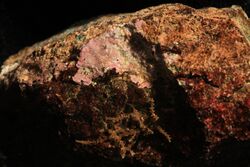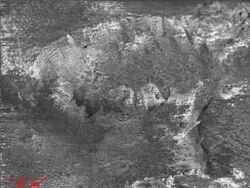Biology:Hildenbrandia
| Hildenbrandia | |
|---|---|

| |
| The darker red alga encrusting this rock fragment is H. crouaniorum | |

| |
| SEM of a H. rivularis gemma. Scale bar: 50 μm | |
| Scientific classification | |
| (unranked): | Archaeplastida |
| Division: | Rhodophyta |
| Class: | Florideophyceae |
| Order: | Hildenbrandiales |
| Family: | Hildenbrandiaceae |
| Genus: | Hildenbrandia Nardo, 1834 |
| Synonyms | |
|
Hildenbrandtia | |
Hildenbrandia is a genus of thalloid red alga comprising about 26 species. The slow-growing, non-mineralized thalli take a crustose form.[1] Hildenbrandia reproduces by means of conceptacles and produces tetraspores.
Morphology
Hildenbrandia cells are around 3–5 μm in diameter and the filaments are around 50–75 μm in height.[2]
The thallus comprises two layers: the hypothallus, which attaches to the rock, and the perithallus, a pseudoparenchymous layer comprising vertical filaments, which unlike coralline red algae is not further differentiated.[3][4]
Growth
Hildenbrandia comprises orderly layers of vertical oblong cells with thick vegetative cell walls, occasionally connected by secondary pit connections with pit plugs in the septal pores.[5] It grows at its margins, away from the centre, and is able to quickly repair any gaps arising by regenerating from a basal layer of cells.[6] As plants become more mature, they become multi-layered and strongly pigmented near their centres, whilst their single-layered margins begin to grow more slowly.[6] Multi-layered areas may develop in the margins; these will detach and float away as gemmae to form new colonies, leaving a single layer of cells beneath them once they separate from the host plant.[6]
Newly settled gemmae form rhizoids.[7]
Conceptacles develop in a haphazard manner; cells in conceptacle regions deform one another and become less regularly shaped as they grow larger.[5]
In a similar fashion to the coralline algae, the outer layer of the thallus is shed seasonally, presumably to avoid colonization by epiphytes.[8]
Taxonomy
The genus name of Hildenbrandia is in honour of Franz Xaver von Hildenbrand (1789-1849), who was an Austrian physician and botanist.[9]
The genus was circumscribed by Giovanni Domenico Nardo in Isis (Oken) vol.27 on page 675 in 1834.
Habitat
The freshwater species H. rivularis[6] and H. angularis[7] seems to form a clade,[10] and require an alkaline pH and hard water, preferring clean water.[11] Unlike most other freshwater red algae (which prefer running water), H. rivularis prefers still water, particularly shady lakes or ponds.[11] H. rubra and other marine species are found in brackish waters, but freshwater / gemma-bearing species cannot tolerate even moderate salinities.[12] The genus is often found in a symbiotic partnership with fungi.[13] Hildenbrandia has a remarkable tolerance to stresses including extreme temperatures, desiccation, and Ultra-violet light; it can be up and photosynthesizing near full capacity just minutes after being cooled to −17 °C or subjected to extreme salinities.[14]
Reproduction
Sexual reproduction has never been observed in any Hildenbrandia species.[12] It can reproduce by splitting into multiple colonies by fragmentation, or via stolons (i.e. sending out lateral branches) or gemmae.[6]
Marine Hildenbrandia, on the other hand, reproduce by means of tetraspores that are produced within the thallus by conceptacles.[7]
Systematics
The genus contains these species[15] (this list is out of date):
- H. angolensis
- H. arracana
- H. canariensis
- H. crouanii
- H. crouaniorum
- H. dawsonii
- H. deusta
- H. expansa
- H. galapagensis
- H. kerguelensis
- H. lecannellieri
- H. lithothamnioides
- H. nardiana
- H. occidentalis
- H. pachythallos
- H. patula
- H. prototypus
- H. ramanaginaii
- H. rivularis
- H. rosea
- H. rubra
- H. sanjuanensis
- H. yessoensis
As of April 2022, the GBIF only accepts 6 species; Hildenbrandia crouaniorum J.Agardh, Hildenbrandia dawsonii, Hildenbrandia occidentalis Setch., 1917, Hildenbrandia rivularis (Liebman) J.Agardh, Hildenbrandia rubra (Sommerfelt) Meneghini and Hildenbrandia sanjuanensis.[16]
Stonehenge
The presence of H. rivularis near Stonehenge has been put forward as a reason for the site's perceived mystical properties. Flint in the Blick Mead spring pools near to the henge takes on a pink hue a couple of hours after being taken out of water due to the presence of the algae. It is assumed that ancient hunter-gatherers would have seen the rocks as having magical properties and would have deemed the site worthy of interest.[17] [18]
References
- ↑ Dethier, M. (1994). "The ecology of intertidal algal crusts: variation within a functional group". Journal of Experimental Marine Biology and Ecology 177: 37–71. doi:10.1016/0022-0981(94)90143-0.
- ↑ Sherwood, A.; Sheath, R. (2000). "Biogeography and systematics of Hildenbrandia (Rhodophyta, Hildenbrandiales) in Europe: inferences from morphometrics and rbcL and 18S rRNA gene sequence analyses". European Journal of Phycology 35 (2): 143–152. doi:10.1080/09670260010001735731.
- ↑ "Hildenbrandia Ben: Morphology". washington.edu. http://depts.washington.edu/fhl/mb/Hildenbrandia_Ben/morphology.html.
- ↑ Cabioch, J.; Giraud, G. (1982). "La structure hildenbrandioïde, stratégie adaptative chez les Florideés" (in French). Phycologia 21 (3): 308–315. doi:10.2216/i0031-8884-21-3-307.1.
- ↑ 5.0 5.1 Pueschel, C. (1982). "Ultrastructural observations of tetrasporangia and conceptacles in Hildenbrandia (Rhodophyta: Hildenbrandiales)". European Journal of Phycology 17 (3): 333–341. doi:10.1080/00071618200650331.
- ↑ 6.0 6.1 6.2 6.3 6.4 Wayne Nichols, H. (1965). "Culture and development of Hildenbrandia rivularis from Denmark and North America". American Journal of Botany 52 (1): 9–15. doi:10.2307/2439969.
- ↑ 7.0 7.1 7.2 Sherwood, A. R.; Sheath, R. G. (2000). "Microscopic analysis and seasonality of gemma production in the freshwater red alga Hildenbrandia angolensis (Hildenbrandiales, Rhodophyta)". Phycological Research 48 (4): 241–249. doi:10.1046/j.1440-1835.2000.00208.x.
- ↑ Pueschel, C. (1988). "Cell sloughing and chloroplast inclusions in Hildenbrandia rubra (Rhodophyta, Hildenbrandiales)". European Journal of Phycology 23: 17–23. doi:10.1080/00071618800650021.
- ↑ Burkhardt, Lotte (2022) (in German) (pdf). Eine Enzyklopädie zu eponymischen Pflanzennamen. Berlin: Botanic Garden and Botanical Museum, Freie Universität Berlin. doi:10.3372/epolist2022. ISBN 978-3-946292-41-8. https://doi.org/10.3372/epolist2022. Retrieved January 27, 2022.
- ↑ Sherwood, A. R.; Sheath, R. G. (2003). "Systematics of the Hildenbrandiales (Rhodophyta): gene sequence and morphometric analyses of global collections". Journal of Phycology 39 (2): 409–422. doi:10.1046/j.1529-8817.2003.01050.x.
- ↑ 11.0 11.1 Eloranta, P.; Kwandrans, J. (2004). "Indicator value of freshwater red algae in running waters for water quality assessment". International Journal of Oceanography and Hydrobiology XXXIII (1): 47–54. ISSN 1730-413X. http://www.oandhs.org/files/60.pdf. Retrieved 2010-10-27.
- ↑ 12.0 12.1 Sherwood, A. R.; Shea, T. B.; Sheath, R. G. (2002). "European freshwater Hildenbrandia (Hildenbrandiales, Rhodophyta) has not been derived from multiple invasions from marine habitats". Phycologia 41: 87–95. doi:10.2216/i0031-8884-41-1-87.1.
- ↑ Saunders, G. W.; Bailey, J. C. (1999). "Molecular systematic analyses indicate that the enigmatic Apophlaea is a member of the Hildenbrandiales (Rhodophyta, Florideophycidae)". Journal of Phycology 35: 171–175. doi:10.1046/j.1529-8817.1999.3510171.x.
- ↑ Garbary, D. (2007). "The Margin of the Sea". Algae and Cyanobacteria in Extreme Environments. Cellular Origin, Life in Extreme Habitats and Astrobiology. 11. pp. 173–191. doi:10.1007/978-1-4020-6112-7_9. ISBN 978-1-4020-6111-0.
- ↑ Guiry, M.D.; Guiry, G.M. (2008). "Hildenbrandia". AlgaeBase. World-wide electronic publication, National University of Ireland, Galway. http://www.algaebase.org/search/genus/detail/?genus_id=22. Retrieved 2009-04-18.
- ↑ "Hildenbrandia Nardo, 1834" (in en). https://www.gbif.org/species/2665375.
- ↑ "Mesolithic settlement near Stonehenge: excavations at Blick Mead, Vespasian's Camp, Amesbury". http://www.silversaffron.co.uk/wp-content/uploads/2014/07/02_Jacques_VespasiansCamp.pdf.
- ↑ Jacques, David (2014). "Mesolithic settlement near Stonehenge: excavations at Blick Mead, Vespasian's Camp, Amesbury". Wiltshire Archaeological and Natural History Magazine 107: 7–27.
External links
- Benjamin Weisgall. "Hildenbrandia spp. : the immortal red crust". FHL Marine Botany. http://depts.washington.edu/fhl/mb/Hildenbrandia_Ben/taxonomy.html: an excellent, accessible overview of the genus.
- Images of Hildenbrandia at Algaebase
Wikidata ☰ Q13636104 entry
 |

